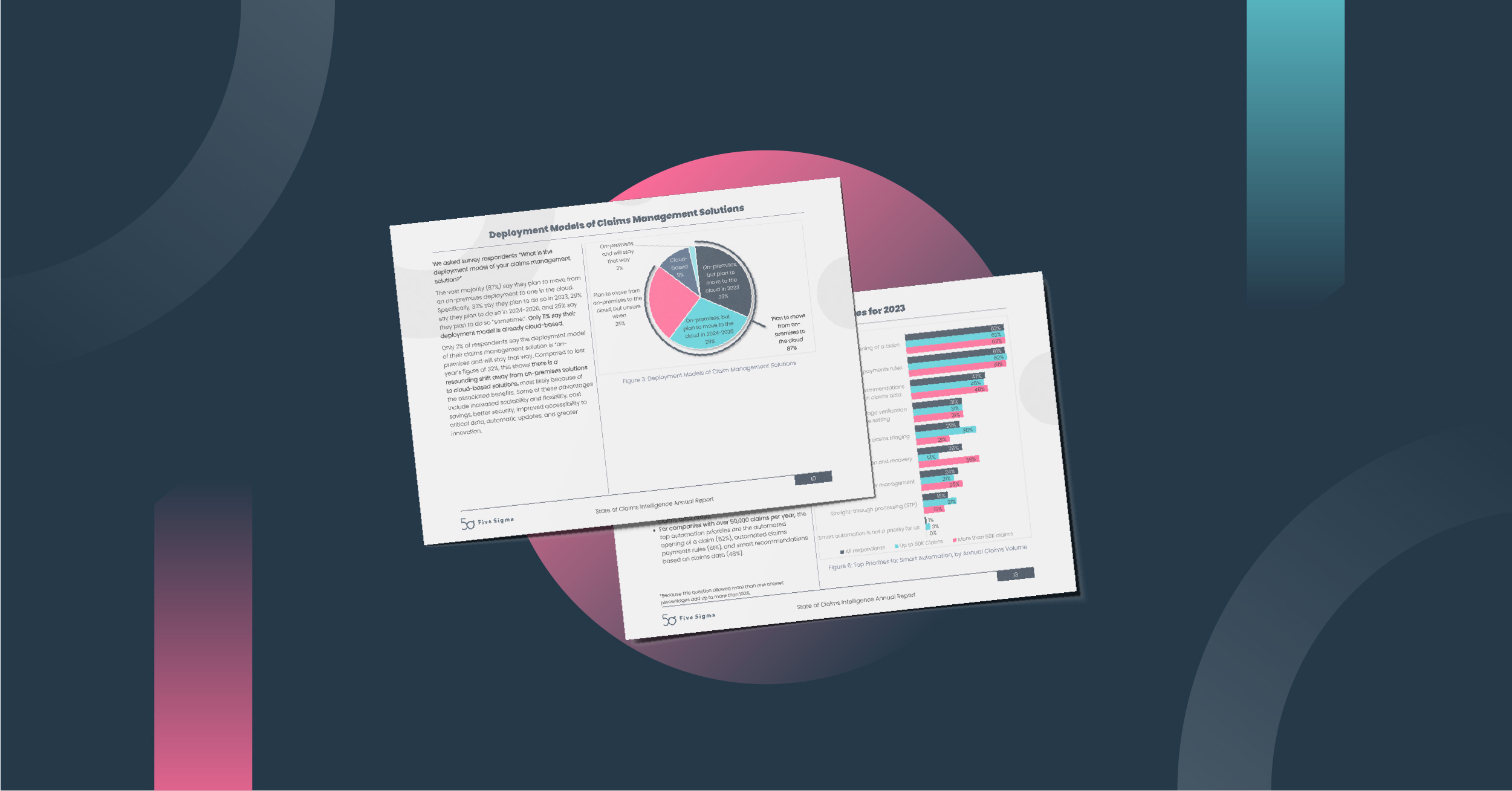FNOL: Optimizing the Claims Process Starts
First Notice of Loss (FNOL) is the initial report to an insurance provider following the loss, theft or damage of an insured asset. Here’s what insurers should consider to optimize claims FNOL and ensure customer loyalty.
Track and field enthusiasts know that a positive outcome for a sprinter is how fast they get out of the blocks when the starter’s pistol sounds. In the claims world, that first and vital burst of speed is generated by the FNOL – First Notice of Loss – or the insurer’s starter’s gun. This crucial phase sets the tone for the entire claims process, so it’s vital that the FNOL flow is flawless if the insurers want to win the race against their competitors.
Insurers can only be competitive when their claims process is technology driven, instantly providing automatically gathered and analyzed data to the adjusters so they can be well-informed and able to drive a quick and accurate process.
What is an FNOL?
First Notice of Loss, also known as the first notification of loss, is the first notification by a policy holder of loss, damage, theft or injury to an asset. It informs their insurer that they have cause to make a claim. The FNOL is generally the first step in the formal claims process lifecycle and takes place before any formal or official claim is filed.
This is a crucial stage in ensuring customer loyalty. An EY study shows that for 87% of policyholders the claims experience impacts their decisions to remain with insurers. And the first step, which sets the tone for the customer, is FNOL.
How does an FNOL work?
When submitting an FNOL there is generally a process that consumers and companies follow. The FNOL usually requires the customer to provide the following key information: policy number, date and time of theft or injury, location of the incident, police report number, a personal account of how the incident occurred, and information on the insurance details of the other party where required.
In the case of a car accident, for example, the insured driver informs the insurance provider of the incident and is matched with a claims adjuster. The adjuster determines the nature and severity of the damage to the policyholder’s vehicle, relying on a police report, the other driver’s testimony, witness accounts, a medical examiner’s report, damage done to the insured car, etc.
Potential Outcomes Following FNOL
The FNOL process can lead to unfavorable outcomes in the claims process, for example, the adjuster could receive different accounts of the event, resulting in an unfair settlement judgment, or investigations could take several weeks, delaying the final settlement. Moreover, there could be errors or omissions due to difficult to read documents, such as a handwritten report of an accident that can be interpreted incorrectly by the adjuster. The result could be denied claims, and extra work to fix the problem later on. This all frustrates the customer who wants a quick turnaround.
On the other hand, for a more favorable outcome in the claims process, automated, AI-based FNOL insurance technology can be implemented to increase accuracy and improve the overall process, providing that well-needed initial burst of speed that both insurers and consumers can benefit from.
Adding Digital and Technology-Driven Products to the FNOL Process
New AI and advanced data modelling technologies can be integrated into the claims system to significantly increase the speed and accuracy of the FNOL process.
With use of mobile devices for web interaction having overtaken desktops since 2017 and continuing to rise, custom mobile apps are taking center stage in simplified claims processing, especially when it comes to FNOL. Covid-19 and the work-from-home transformation pushed the adoption of digital FNOL submission ( eFNOL). Customers can now submit an FNOL, as well as check their claim status via their phones, sending incident data swiftly to the insurance company.

Source: Five Sigma Claims Performance Benchmarks Report 2023
The FNOL process can take advantage of the Internet of Things/Telematics to send automatic notifications of incidents to the insurer in real time. For example, following a road accident, the driver can immediately begin the FNOL process via an insurer’s mobile app, uploading detailed photos of the accident, or even submitting recorded witness statements. And advanced telematics data, such as video images captured during the accident, can be downloaded from the cloud to automatically trigger an FNOL.
IoT enables instant notification of damage, for example, if the airbags inflate during a car accident, an automatic alert can be sent to the insurer.
Drones and satellites can survey damage and collect information about property damage during and following a catastrophic event such as a hurricane, a fire, or flooding, to initiate claims even before the homeowner makes contact. Customers can also submit photos of damage to their homes or vehicles to the insurer via intuitive apps or other interfaces as an FNOL.
Computer vision models can assess the cost of the loss by evaluating data from videos and photographs taken by policyholders or claims adjusters submitted in an FNOL. This helps the insurer to quickly assess damage costs and predict their liabilities so they can secure their financial resources accordingly.
These technologies provide information that is unimpacted by human error or subjectivity, and the insurer can deem it an FNOL. This ensures that the adjuster receives accurate and consistent data that they can score to accurately determine the extent of loss.
In addition to speeding up the entire claims process from FNOL onwards, these smart technologies help detect and prevent insurance fraud, which often starts at the claims stage. The use of connected smart devices eliminates the manual interference of potential fraudsters, by alerting insurers to a claim instantly. So, for example, at the time of a car accident, the insurer can receive FNOL immediately without the policyholder having to contact them, enabling claims processing to begin as soon as the damage occurs. AI can help ensure that the photographic evidence reflects the events described in the FNOL, and evaluate any discrepancies. This prevents the less than honest from manipulating data for fraudulent purposes.
The Financial Impact of FNOL
According to Deloitte, claims is an insurer’s biggest cost component, accounting for about 70% of US premiums collected in 2020. By implementing these technologies, insurers can increase efficiency, productivity, and accuracy, saving vital costs that impact the bottom line. Making AI and advanced data modelling part of the FNOL process is the next step in increasing customer satisfaction and reducing churn. Satisfied customers are customers who renew their policies.
For insurers, creating an efficient and accurate AI-powered FNOL process flow also translates into administrative savings on employing additional staff to review documents and type data manually into systems. An automated FNOL flow enables claims handlers to shift their focus to high-value cases resulting. When the claims system can’t make a decision and fully automate a claim, such as when the cost of repairing a car is similar to the cost of total loss, a human adjuster investigates, while the automated system takes care of the time-consuming data processing tasks – it’s cost effective. And a quick automation process means that insurers can process more claims per day, reducing the average cost per claim overall.
As we’ve already mentioned, automated FNOL reduces fraud. Not only can the insurer gain from eliminating fraudulent claims because of the superior ability of AI-driven FNOL processes to detect irregularities in the claim, but fewer resources will be wasted on investigating false claims as well.
Improving the FNOL Process with Five Sigma
When do customers submit an FNOL? It happens at a time of crisis, when they most need the insurer. So if the process is flawed and inefficient, with long waiting times and incorrect recommendations, customer satisfaction will be impacted. A well-structured, automated FNOL process can turn your customer’s difficult moments into an opportunity for increased loyalty and retention.
With the Five Sigma SaaS digital claims management solution (CMS), all FNOL data received from the insurer’s digital channels is automatically embedded into our workflows and is readily available for the next step in the process.
Some claimants don’t use digital forms, and instead open a claim by calling the insurer. The Five Sigma system supports voice call information collection via simple screens and workflows for the insurer’s customer support. This enables every insurer is able to implement the FNOL process in the best way to support their business.
Five Sigma’s CMS offers quick access to all data related to the claim, e.g., exposures, coverages, method of inspection, indemnity reserve, etc., so the adjuster has everything they need to make informed decisions and to efficiently communicate with the customers.
Conclusion
Staying ahead of the competition when it comes to claims process starts with offering an efficient and automated FNOL claims process. It gives the insurer a head start on increasing customer satisfaction while reducing overheads and enabling adjusters to focus on what is truly important.
By using advanced AI-based technologies, insurers can make the FNOL happen within minutes of any event taking place, and ensure that the data received is accurate and reliable. The goal is to speed up the end-to-end claims process using AI and advanced data modelling, reduce wasted effort, cut down on fraud opportunities and increase customer satisfaction. Five Sigma offers a digital claims management solution (CMS) that automatically turns all FNOL data into rapid identification of claim types, enables seamless communication with claimants, and ensures automated triage and adjuster assignment.
It’s a winning strategy in the race for customer loyalty and operational efficiency.
Frequently Asked Questions
What is Insurtech?
Insurtech is a combination of the words “insurance” and “technology,” similar to the term fintech. Insurtech is the use of new technologies that are transforming the insurance industry, reducing costs for consumers and insurance companies, improving efficiency, simplifying policy management and enhancing customer satisfaction.
What is an appraisal?
An appraisal is a documented assessment of a property’s fair market value by an authorized professional. Appraisals are used to calculate the cost of replacing a property or to determine the amount of damage to the property after a covered event.
What is an insurance claim?
An insurance claim is a formal request by a policyholder to an insurance company for coverage, compensation or reimbursement against losses covered by an insurance policy.
What is the meaning of claims adjuster?
Claims adjusters are professionals tasked with investigating insurance claims and evaluating how much money should be paid out to claimants.



